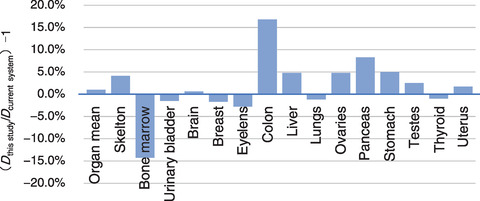
Fig.4-9 Structure of this study

Fig.4-10 Percentage difference between organ doses obtained from this study (Dthis study) and current dosimetry system (Dcurrent system)
Epidemiological studies of atomic bomb (A-bomb) survivors conducted by the Radiation Effects Research Foundation (RERF) are some of the most important resources for data on the effects of radiation on human health. The precise estimation of the organ doses is key to these studies, and the dosimetry system used to estimate the doses received by individual organs in each survivor has evolved and improved over the years. A joint Japan-U.S. project team comprising the Nuclear Science and Engineering Center of JAEA, RERF, the University of Florida (UF), and the U.S. National Cancer Institute (NCI) was formed to further refine the dosimetry estimation system (Fig.4-9).
Members of this project team developed a set of models of the human body (known as phantoms) for adults, children, and pregnant women by precisely reproducing the standard body dimensions of Japanese people in 1945, modeled in detail using the latest-available CT images and other information. The project team also established a method for more accurately estimating the organ doses of A-bomb survivors with these phantoms using the latest computational techniques, such as PHITS, which was developed mainly by JAEA. Based on idealized conditions in hypothetical survivors, our initial comparisons of doses using the developed phantoms and methods with doses derived from the current dosimetry system found that doses were generally consistent, although dose estimates for some organs changed by as much as ±15% (Fig.4-10).
The results of this collaborative effort have been published in the journal “Radiation Research” as a series of three articles. They will be used to continue updating organ doses within the epidemiological study of the atomic bomb survivors.
This research is part of the results of the joint research with Radiation Effects Research Foundation (RERF), “Joint research on the development of exposure dose calculation methods for atomic bomb survivors”.
(Tatsuhiko Sato)